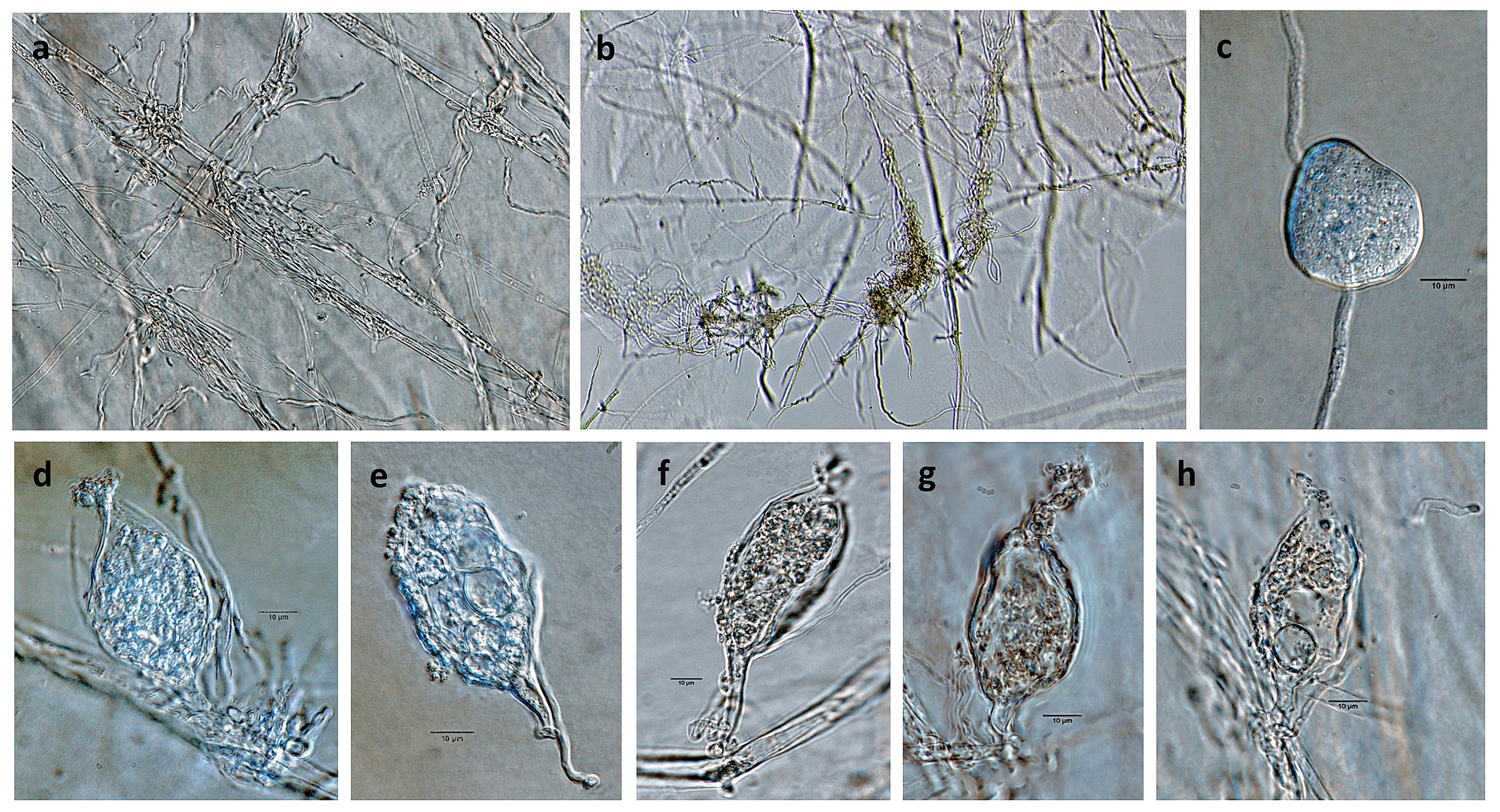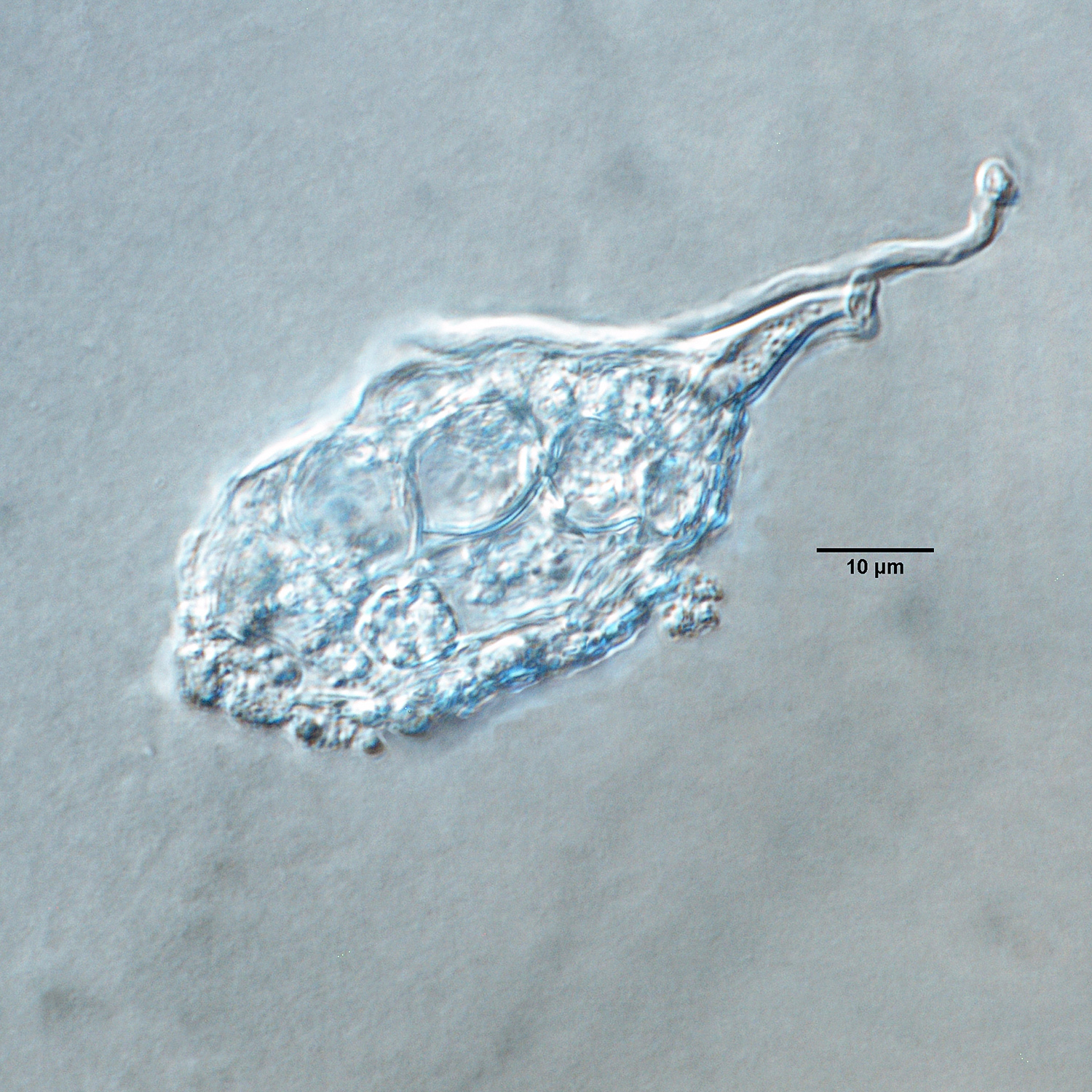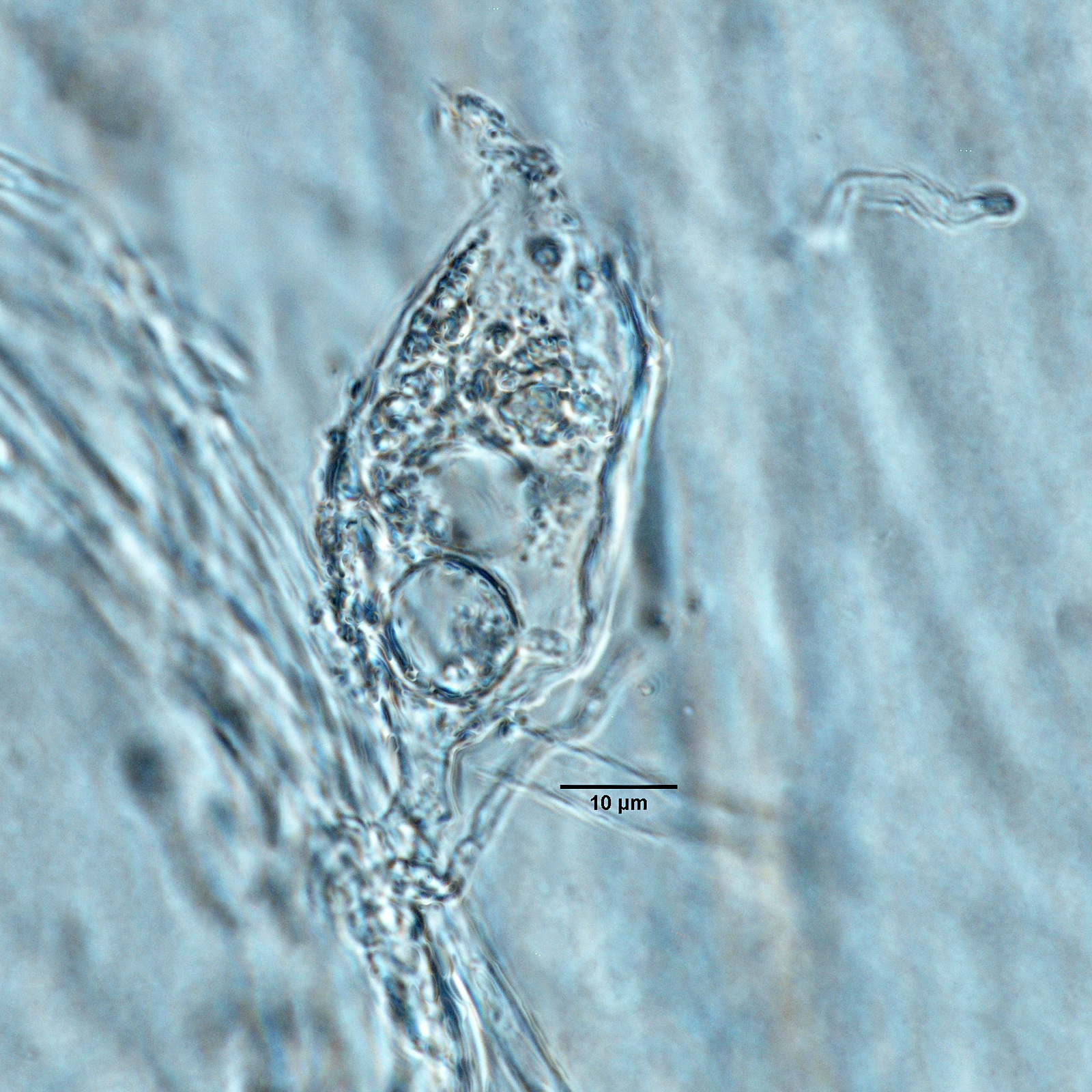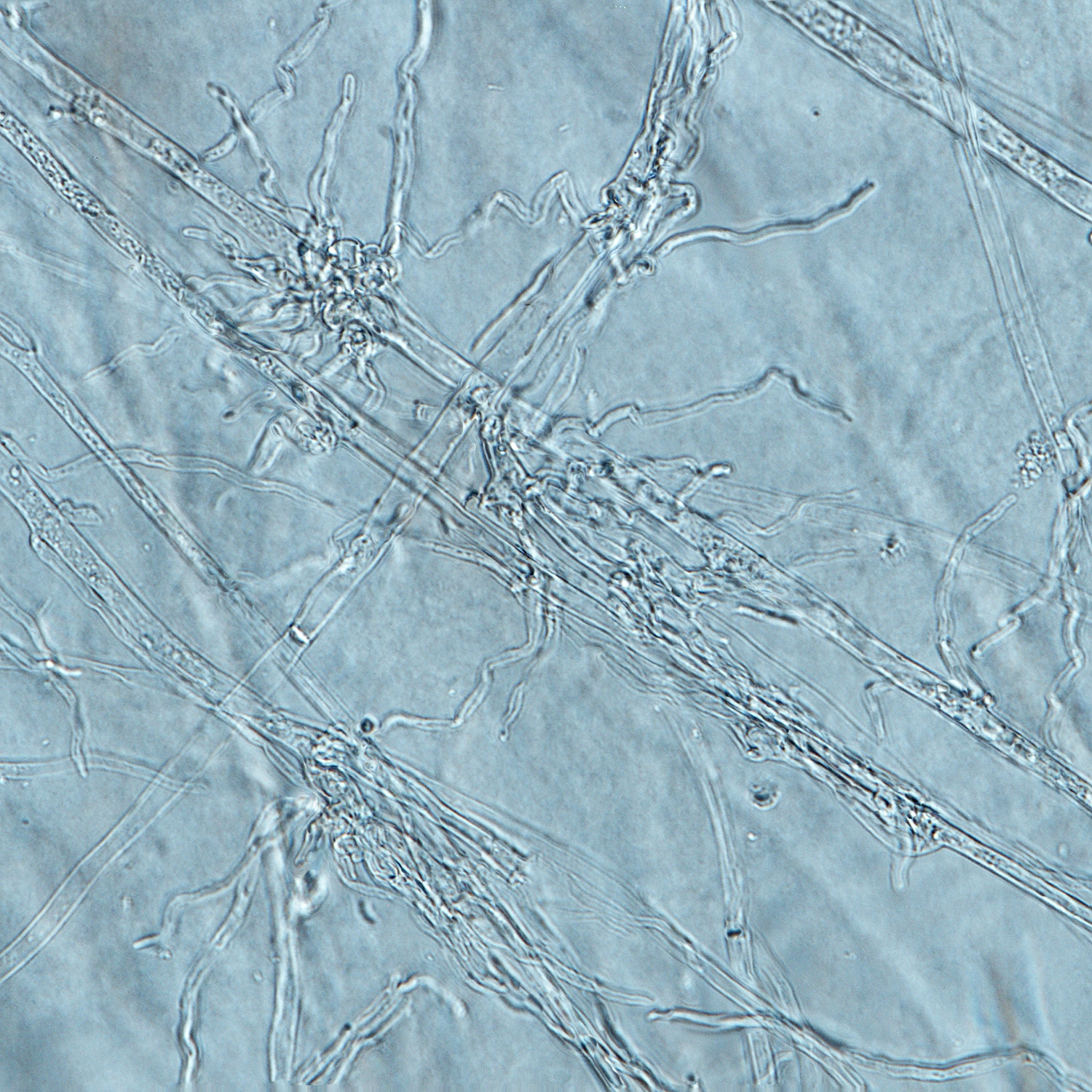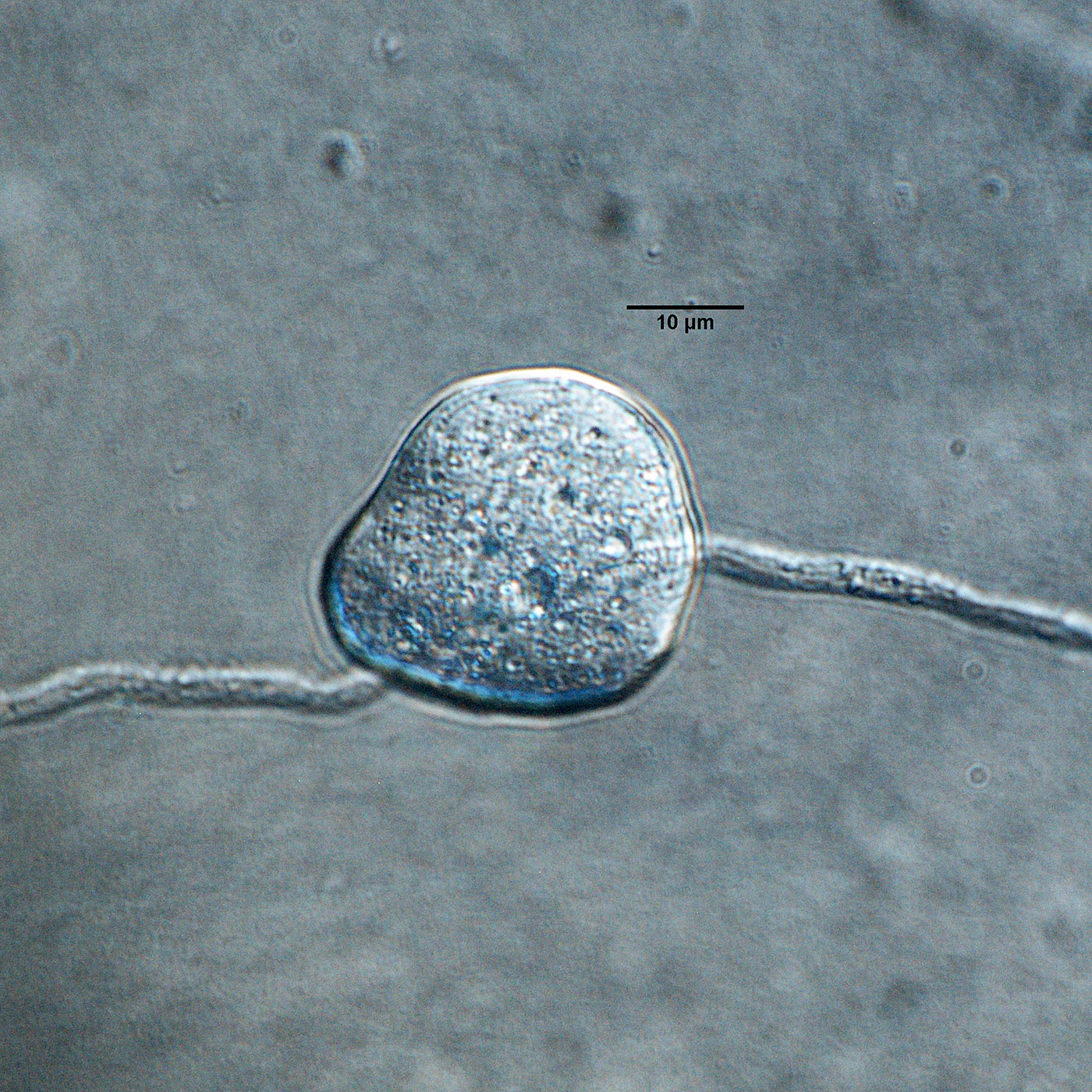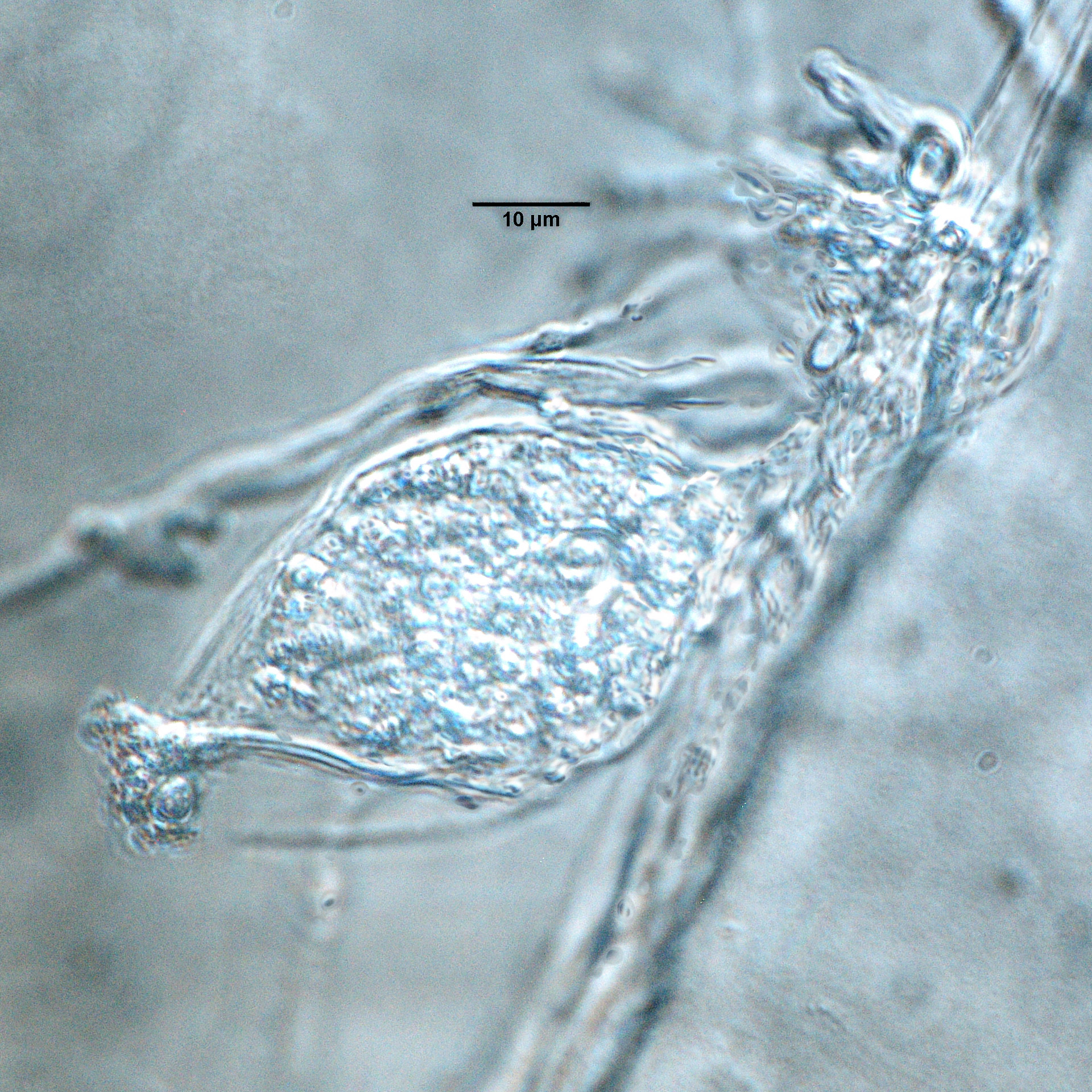Phytophthora pinifolia
|
Phytophthora spp. in subclade 6b: portion of the seven-loci ML phylogeny featuring the type cultures of 212 described species (by T. Bourret). Notice the position of P. pinifolia Ex-type CBS 122924 = S&T BL 49. Gloria Abad, USDA S&T.
|
|
Phytophthora spp. in subclade 6b: Morphological Tabular key (PDF) and Tabular key legends (PDF) in IDphy2 KEY SECTION. Notice the data of P. pinifolia Ex-type CBS 122924 = S&T BL 49. Gloria Abad, USDA S&T.
|
|
Phytophthora pinifolia colonies grown for 7 days on (a) V8® Agar, (b) potato dextrose agar, and (c) malt extract agar; photo by Krysta Jennings and Leandra Knight, USDA-APHIS-PPQ |
|
Phytophthora pinifolia (ex-type CPHST BL 49) asexual phase of the sterile species (a–h): (a, b) mycelia and hyphal swellings; (c–h) sporangia; photos by Gloria Abad, USDA-APHIS-PPQ. |
|
Phytophthora pinifolia (ex-type CPHST BL 49) asexual phase of the sterile species: nonpapillate sporangium; photo by Gloria Abad, USDA-APHIS-PPQ. |
|
Phytophthora pinifolia (ex-type CPHST BL 49) asexual phase of the sterile species: nonpapillate sporangium; photo by Gloria Abad, USDA-APHIS-PPQ. |
|
Phytophthora pinifolia (ex-type CPHST BL 49) asexual phase of the sterile species: mycelia and hyphal swellings; photo by Gloria Abad, USDA-APHIS-PPQ. |
|
Phytophthora pinifolia (ex-type CPHST BL 49) asexual phase of the sterile species: nonpapillate sporangium releasing spores; photo by Gloria Abad, USDA-APHIS-PPQ. |
|
Phytophthora pinifolia (ex-type CPHST BL 49) asexual phase of the sterile species: mycelia and hyphal swellings; photo by Gloria Abad, USDA-APHIS-PPQ. |
|
Phytophthora pinifolia (ex-type CPHST BL 49) asexual phase of the sterile species: nonpapillate sporangium; photo by Gloria Abad, USDA-APHIS-PPQ. |
|
Phytophthora pinifolia (ex-type CPHST BL 49) asexual phase of the sterile species: nonpapillate sporangium; photo by Gloria Abad, USDA-APHIS-PPQ. |
Name and publication
Phytophthora pinifolia Alv. Durán, Gryzenh. & M.J. Wingf. (2008)
Durán A, Gryzenhout M, Slippers B, Ahumada R, Rotella A, Flores F, Wingfield BD, and Wingfield MJ. 2008. Phytophthora pinifolia sp. nov. associated with a serious needle disease of Pinus radiata in Chile. Plant Pathol. 57: 715–727.
Corresponding author: alvaro.duran@fabi.up.ac.za
Nomenclature
from Durán et al. (2008)
Mycobank
Etymology
‘Pinifolia’ refers to the occurrence of the organism on the needles of Pinus radiata.
Typification
Type: CHILE isolated from Pinus radiata in Arauco province, Arauco, Llico plantation, July 2007 by M.J. Wingfield; holotype: PREM 59887
Ex-type: CBS 122924, P16100, CMW 26668
Sequences for ex-type in original manuscript: CMW 26668 = ITS = EU725806, CoxII EU725811 (Martin and Tooley FM35 & FM58)
Ex-type in other collections
(ET) CBS 122924, CMW 26668, WPC P16100, S&T BL 49 (Abad), 47H1 (Hong), TJ 0074 (Jung)
Molecular identification
Voucher sequences for barcoding genes (ITS rDNA and COI) of the ex-type (see Molecular protocols page)
Phytophthora pinifolia isolate CPHST BL 49 (= P16100 WPC) = ITS rDNA MG865566, COI MH136958
Voucher sequences for Molecular Toolbox with seven genes (ITS, β-tub, COI, EF1α, HSP90, L10, and YPT1
(see Molecular protocols page) (In Progress)
Voucher sequences for Metabarcoding High-throughput Sequencing (HTS) Technologies [Molecular Operational Taxonomic Unit (MOTU)]
(see Molecular protocols page) (In Progress)
Sequences with multiple genes for ex-type in other sources
- NCBI: Phytophthora pinifolia CPHST BL 49
- NCBI: Phytophthora pinifolia P16100
- NCBI: Phytophthora pinifolia CBS 122924
- NCBI: Phytophthora pinifolia CMW 26668
- EPPO-Q-bank: Phytophthora pinifolia CBS 122924
- BOLDSYSTEMS: Phytophthora pinifolia PHYTO124-10 = P16100 (barcoding COI & ITS)
Position in multigenic phylogeny with 7 genes (ITS, β-tub, COI, EF1α, HSP90, L10, and YPT1)
Clade clade:
a taxonomic group of organisms classified together on the basis of homologous features traced to a common ancestor
6b
Genome sequence
Phytophthora pinifolia strain ex-type CBS 122922. Accession genome ASM50022v2 reference, BioProject PRJNA190828, Tree Aggressors Identification using Genomic Approaches (2016), Feau et al 2016
Morphological identification
adapted from Durán et al. (2008)
Colonies and cardinal temperatures
Colony colony:
assemblage of hyphae which usually develops form a single source and grows in a coordinated way
morphology after 7 days of growth on V8 agar, potato dextrose agar, and malt extract agar with no distinctive pattern. Minimum temperature for growth is xx°C, optimum xx°C, and maximum xx°C.
Conditions for growth and sporulation
Sporangia produced abundantly in soil extract water and rare in culture.
Asexual phase
SporangiaSporangia:
sac within which zoospores form, especially when water is cooled to about 10°C below ambient temperature; in solid substrates, sporangia usually germinate by germ tubes
nonpapillatenonpapillate:
pertaining to the production of a non-distinct, or inconspicuous, papilla at the distal end of the sporangium (cf. papillate and semipapillate)
; persistentpersistent:
pertaining to sporangia that remain attached to the sporangiophore and do not separate or detach easily (cf. caducous)
; globoseglobose:
having a rounded form resembling that of a sphere
to ovoidovoid:
egg-shaped, with the widest part at the base of the sporangium and the narrow part at the apex
, obpyriformobpyriform:
inversely pear-shaped, i.e. with the widest part at the point of attachment (cf. pyriform)
(39–61µm L × 27–45 μm W); ocassionally germinating directly; sporangiasporangia:
sac within which zoospores form, especially when water is cooled to about 10°C below ambient temperature; in solid substrates, sporangia usually germinate by germ tubes
produced in unbranched sporangiophores. Hyphal swellings spherically radiating. ChlamydosporesChlamydospores:
an asexual spore with a thickened inner wall that is delimited from the mycelium by a septum; may be terminal or intercalary, and survives for long periods in soil
absent.
Sexual phase
Sterile.
Additional specimen(s) evaluated
Phytophthora pinifolia, ex-type CPHST BL 49, duplicate of P16100 (World Phytophthora Collection)
Hosts and distribution
Distribution: South America (Chile)
Substrate: needles, shoots
Disease note: downy mildew, needle disease, stem necrosis
Host: Pinus radiata (Pinaceae)
Retrieved February 01, 2018 from U.S. National Fungus Collections Nomenclature Database.
Quarantine status
USA: This species was listed as a species of concern during the 2009 Phytophthora prioritization project conducted by USDA APHIS PPQ CPHST PERAL (Schwartzburg et al.).
EPPO alert list 12.2012: Phytophthora pinifolia; panel review date 03.2012 (previously listed pests are at the bottom of this page)
Additional references and links
- SMML USDA-ARS: Phytophthora pinifolia
- EPPO Global Database: Phytophthora pinifolia
- Forest Phytophthoras of the World: Phytophthora pinifolia
- CABI Digital Library: Phytophthora pinifolia
- Encyclopedia of Life (EOL): Phytophthora pinifolia
- Index Fungorum (IF): Phytophthora pinifolia
- Google All Phytophthora pinifolia
- Google Images Phytophthora pinifolia
- Google Scholar Phytophthora pinifolia
Fact sheet author
Z. Gloria Abad, Ph.D., USDA-APHIS-PPQ-S&T Plant Pathogen Confirmatory Diagnostics Laboratory (PPCDL), United States of America.


